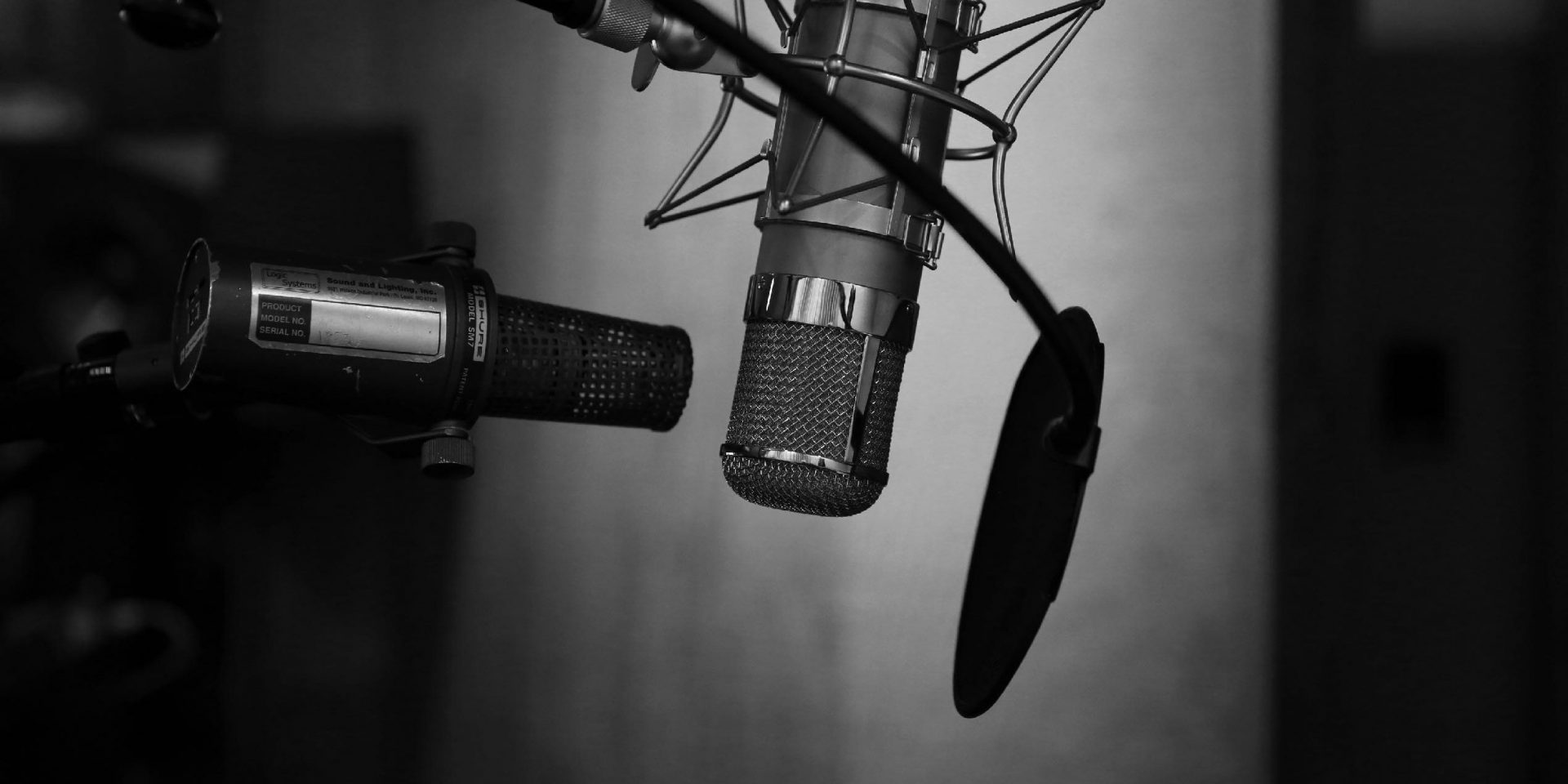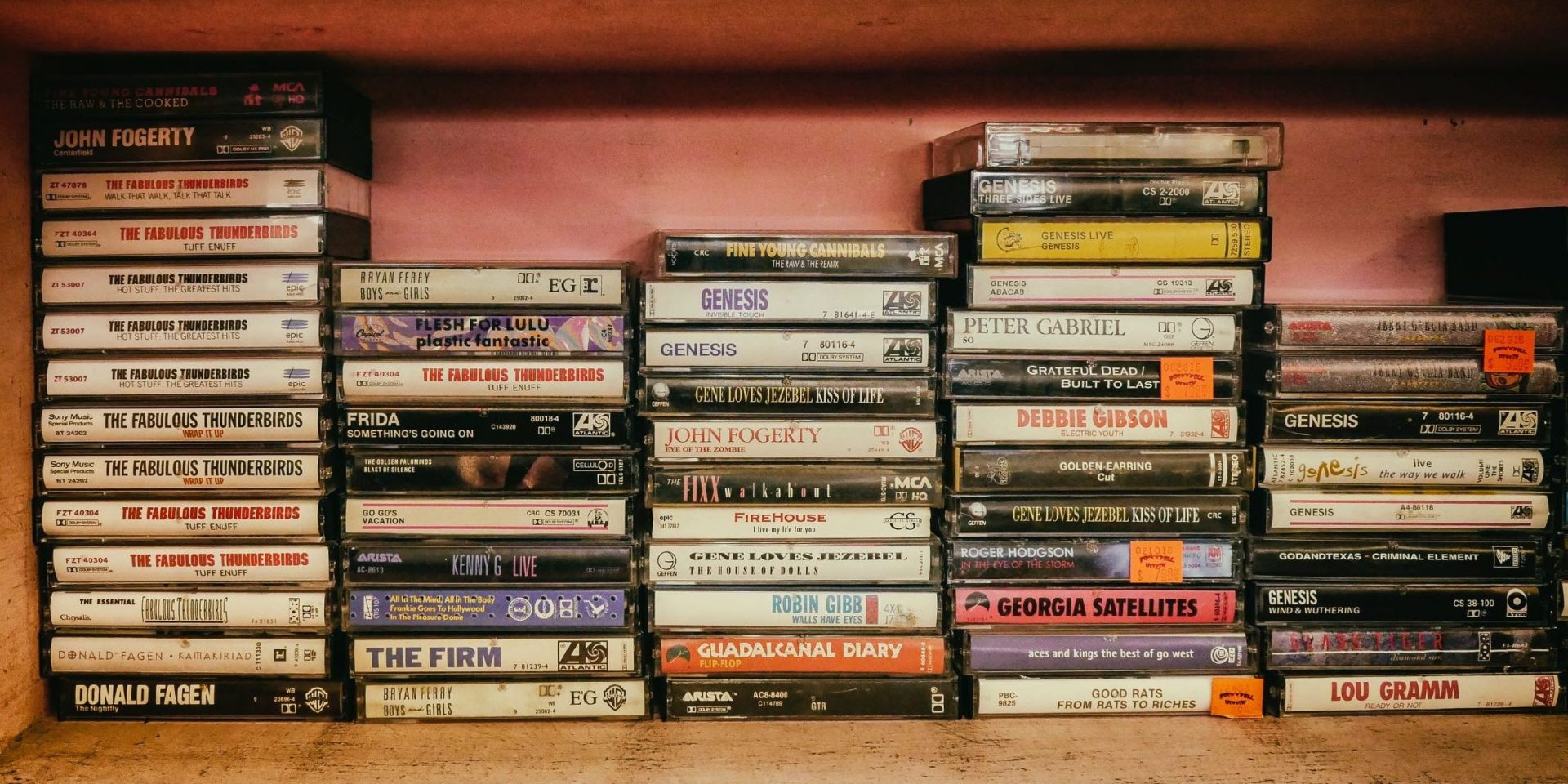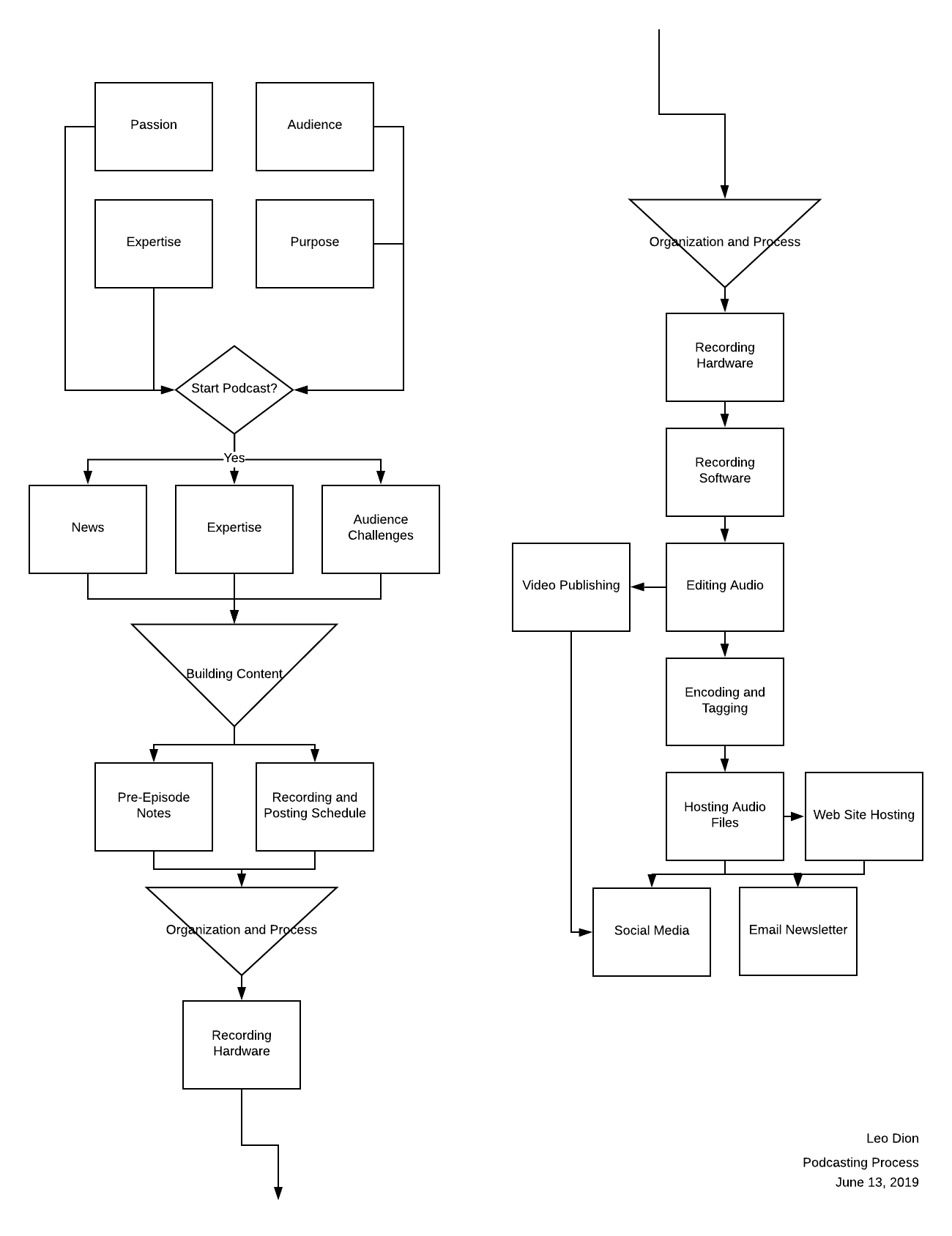It has been at least 15 years but I remember as soon as iTunes came to Windows, I downloaded podcasts. For example, it could have been the software development podcast, dotNet Rocks, or the financial podcast, Planet Money, giving a narration and analysis of the 2008 Financial Crash as it happened. Generally speaking, podcasting as these podcasts do, gives specific audiences an in-depth specialized analysis without the need to appeal to the general audience.
Therefore in 2017, I decided to jump into podcasting and start two podcasts: one on personal productivity and another for my business on software development for Apple hardware. Important to realize, both podcasts are some sort of combination of passion, business, and expertise. And so, I want to talk about the ins and outs of podcasting. That means:
- Why should you start a podcast
- How to build content
- How to stay organized
- Recording and editing audio
- Hosting and Publishing
- Reaching Your Audience
First of all, the #1 question you should ask is why you should start a podcast.

Why Should You Start a Podcast?
Podcasting may sound simple at first but to really be successful at it you need perseverance. Therefore, you need to really have a good reason and passion to do for a while. For this reason, rather than discussing how to start podcast let’s discuss the why.
Promote Yourself and Your Skills
Most importantly, sharing your expertise on the web provides a great example to others. However, more so than a written format, talking about a topic is a more natural means for people. Uniquely, rather than giving a talk to 40 people, podcasting allows you to present on topic many times over. In addition, not only can you sell yourself but a product as well.
Sell A Product
Podcasting can be a great way to sell your products. By starting a podcast, you can give your products a narrative and showcase as to how they are helpful. However, the most important part of selling anything on the web is to provide actual informative valuable content. Don’t just sell but provide advice - You build trust as well as true expertise on the product’s subject matter.
Enjoy a Topic or Hobby through Podcasting
While selling yourself or your products are good reasons, you need to have some sense of enjoyment or passion to really carry out the momentum of producing a podcast show. Recently on Pat Flynn’s Smart Passive Income podcast, he interviewed MKBHD, a YouTube tech reviewer with over 8 million subscribers. MKBHD revealed on the show he produced 100 videos before he even had 100 subscribers. Building an audience with your show is going to be a long and slow process. For this reason, having enjoyment and passion in podcasting will give you the momentum to carry it through that long process. As a result, if you do decide to start a show though, it’s important to know where to start.
How To Get Started Podcasting?
Podcasting involves five components: content, organization, audio, hosting, and reaching your audience. With this in mind, having engaging content is perhaps the most important.

Building Content
Based on why you starting your podcast and the type of show you are doing, you need to build a list of topics for your show. With this intention, you need build on your existing expertise and passion while also finding your audience and seeking their pain points.
Build On Your Existing Expertise and Passion
As a result, by building on your passion and expertise, you sound natural and engaging. Nevertheless, if you get stuck compiling a list of topics based on your expertise alone, you can look to your potential audience online. Additionally your audience online will give you insight into their questions or challenges.
Find Your Audience and Their Challenges
The web is a great way to reach your audience but it’s also a great way for you to find your audience and the challenges they face. For example, Reddit, Quora, Stackoverflow, Slack Workspace, Youtube Comments, Twitter, Facebook Groups, and any website forum - as long as there is engagement there - is a great opportunity to see what your audience is facing as far as difficulties and where their pain is. They don’t need to be listeners of your podcast already - they just need to be the people you are targeting. Along with your knowledge, you should have enough content to get started. The important thing is to keep that content organized.

Staying Organized
There are two key components to staying organized with your podcast: having prepared notes before you record and having a consistent recording and publishing schedule.
Have Prepared Notes Before You Record
Behind the scenes of every great show are some sort of notes when it comes to the topic of each episode. Moreover, even when talking off-the-cuff, it’s important to have anchor points for your discussion. Furthermore, some shows even go so far so to have a complete script. In the end, it really depends on you and the type of show you are producing. Most importantly, the worst flaw is losing your train of thought and having not enough to talk about. Therefore, the most natural way of doing this is by talking about what you are an expert at and passionate about. As a result, there are several methods of breaking down any topic into prepared notes:
- 5 W’s - Who, What, Where, Why, HoW
- Chronological Narrative
- Essay Format - Thesis Statement with Three Points
With this in mind, whatever format you choose make sure you have a structure and stick with it. If your content has structure, it will give your audience an easier way to organize the content and make it memorable. In addition, building these pre-show notes are a great way to indicate to yourself that you have enough content. Afterwards, these pre-show notes give you an skeleton you will fill in later for the show notes which will be posted publicly with your episode’s metadata. For example, check out this sample from the episodes Erik and I did for OK Productive on the book Atomic Habits by James Clear. In the same way pre-show notes give you a skeleton to work with, consistency in your schedule can help continue your show’s momentum.
Have A Consistent Schedule
Having a consistent schedule, both in recording and publishing, sets your audience expectations and makes sure you build a habit and flow with recording. For example, what I do set aside every Thursday morning to record an episode of each of my podcasts and publish every other week each podcast. By doing this, I have built a habit and expectation on my part that I’ll record every week. Additionally, with the recording to publishing ratio being 2:1, I have now a buffer of episodes, in case something happens: sickness, vacation, etc…. As far as publishing, I have a pretty consistent schedule, publishing every Saturday night or early Sunday morning. Based on playing around with different days, it seems most folks download episodes at the beginning of the work week. This could differ with your audience but clearly setting those expectations are helpful to your audience. Now that we have pre-episode notes and a regular recording schedule, let’s talk about recording.

Working with Audio
The most technical aspect of podcasting is recording and editing your episode. However before we began, I want to reiterate one point: don’t sink money in the best equipment until you are sure that you’ll stick with podcasting. Surprisingly, you may already have much of the equipment and there is plenty of free software to do this. As a result, I’d recommend spending some money on better equipment and software perhaps around the 6 month - 9 month time range or once you’ve recorded approximately 10 - 12 episodes and have a rhythm in your schedule. Firstly, the equipment which takes in your voice before anything else is going to be your microphone.
Your Podcasting Microphone
Your microphone is going to be your first connection to your audience. When first starting off, I’d recommend using a microphone - any microphone. Most importantly, don’t rely on your laptop microphone and webcam microphone for your audio. In addition, test your audio recording before moving to an editing phase. As far as microphone upgrades, the next step is spending money ($50 - $99) on something like what I use: Audio-Technica ATR2100-USB In addition, they also sell a combo which include a pop filter and studio, that I use and highly recommend.
Once you’ve reached a point where you wish to go even more professional, you’ll want to look a more expensive microphones and a mixer/pre-amp. These will give an even better sound, more control, and better realtime feedback of your audio. Here are some links which you might find helpful:
- Transistor.FM - How to start a podcast
- The Best Podcast Microphones on the Market
- 25 of the Best Podcast Microphones For Any Budget
Therefore, once you have a good microphone for recording, you’ll need software to record your audio.
Recording and Editing Your Audio
Recording software can be fairly simple and inexpensive. For example, there’s free software such as Garageband and
Audacityfor macOS and Windows/Linux respectively. However, if you are planning to edit your podcast then it maybe worth your money to purchase something like: Apple’s Logic Pro or Adobe Audition which give you more granular control over editing functionality.
Remote Interviews
Specifically, remote interviews can present its fair share of challenges. For example there are recording apps such as
Zencasterwhich specialize in this. Additionally, you could also record your interview over a conferencing service like Zoom or Google Hangouts strip the audio portion and turn that into an episode. Surprisingly though, the conferencing choice of most podcasters is Skype. However you’ll want to record you and your interviewee on separate tracks. For instance as a macOS user, I use Soundflower to map my audio channels properly (i.e. my microphone and Skype audio to separate tracks). Furthermore, I also encourage my guest to record there own audio since sound quality via Skype isn’t the best.
Editing Audio
Therefore, once you’ve recorded your audio, the next step is editing. Most importantly, having a great recording helps increase the quality of the recording overall. That is to say avoiding filler words, dead air, and meandering rants will improve the quality over any recording. However, in the end, editing will typically be needed. With editing, you want to make sure your sound is clear (and there are a variety of filters to do this).
Editing can also be the most time consuming. For this reason, I’ve started outsourcing my editing. Another alternative is using something like Descript, a next-generation audio/video editing platform. I primarily use it for transcribing episodes but it’s actually capable of doing full audio and video editing. Lastly, we’ll need to export the file.
Exporting and Tagging Your Files
An often forgotten step is including helpful metadata and proper formatting of the resulting mp3 file. Therefore, include the correct podcasting metadata and be sure to export as a mono 64kpbs mp3 file. Luckily, most editing tools provide a means to attach metadata such as podcast title, episode title, summary, and chapters with your episode. In the end, you’ll have your brand new episode as an mp3 file. The question then becomes where to upload your file.

Podcasting Hosts and Publishing
Hosting your show can tend to be a bit of a maze:
- a place to put your mp3 file
- a place to host your show’s website
- a way to broadcast to various MP3 players
Hosting Your Mp3 Files
First thing first, do not try to host your own mp3 files. In contract to simple web pages, these can take several MBs of data and when as many as a hundred people are downloading your episodes you can be bitten by download limits, speed issues, and various other issues. For example, when I first started out, I hosted the website on Wordpress and the mp3 files on Amazon S3. In reality, this involved a lot of manual processes with each episode. Therefore, once my Wordpress sites were hacked, I knew I had transition to a dedicated podcast hosting provider. As a result, I moved to Transistor, which has worked out fantastically. Other services which do this are:
Significantly, remember with all these hosts, there could be download caps, ad insertion, speed throttling and more which could hinderacne your experience. In the end you’ll get what you pay for.
Be that as it may, each host will provide a place to upload your mp3 files, provide additional metadata, as well as more elaborate public show notes (as opposed to the pre-show notes you use for talking points). In the end you should have a publicly available RSS feed for your show.
Publishing to the Web
As far a website, services like Transistor, come with a website of some sort and other services like Blubrry integrate with Wordpress. However what’s even more important than a website is making sure your audio is delivered to the numerous podcast clients. Therefore, each podcasting host will deliver an RSS feed which contains metadata about the show as well as continually updated list of episodes. As as result, you’ll use this to claim ownership of your podcast. Consequently, before submitting, make sure you have at the very least 3 episodes uploaded as well as a correct author email address setup with your podcast host. With this in mind, while most clients let you manually add RSS feeds, most users will expect to find your show by searching. Therefore, here is a brief list of clients and how to get your show posted there:
iTunes
Sign up through podcast connect with your show’s RSS feed. This is also used by Overcast and Castro as well.
Google Play Music
Sign up at Google Play Music Podcasts with your show’s RSS feed and validate with your author email address.
Google Podcasts
As long as your website is easily searchable, Google should add it automatically. Use Google Webmaster Tools to verify this and be patient as it can take several days.
Spotify
Go to Spotify for Podcasters and submit your RSS feed and validate. Some podcast host services offer this automatically such as Transistor.FM.
Stitcher
Submit your RSS feed through the partner portal and validate your email address.
Breaker
Submit your RSS feed through Breaker Upstream and verify your email address.
Pocket Casts
Submit your RSS feed to Pocket Casts and validate your email address.
Pandora
Submit your RSS feed at the Pandora AMP Playbook.CastBox.fm
Apply through creator studio and confirm with email address.
Radio Public
Submit your RSS feed for Radio Public here and validate your email address.
Tune In
Submit your RSS feed and other info to Tune In here.
Most importantly, for many of these services, it could take days for submission to work. Surprisingly, some clients like iTunes Connect, actually mirror, or download and re-host your podcast on their platform. Additionally, if you are interested in reaching Alexa, check out this talk I hosted recently where Paul Schmidt talks about turning podcast episodes into Alexa skills. As a result, now that we have our podcast available on a variety of platforms the next step is reaching your audience.
Reaching Your Podcast Audience
Congrats on getting your show recorded, edited, and hosted. However the real challenge in podcasting comes from growing your audience. In that case, part of that is SEO tricks which can take advantage of Google and various podcast clients. Rather, you can go back to how you found your audience earlier and answer those questions with summaries and subscribable links to your episodes. By this means, you can realiably reach your audience directly.
Sharing on Social Media
Social media has its advantages and disadvantages. However, if you don’t have an existing audience, it can lead to not much return on your time. Nevertheless if you do post to social media, make sure it’s a platform your audience uses. For instance, converting 30 second clips into videos are a great way to capture your audiences attention. Such as, this script I have written to convert 30 second mp3 files into videos for social media. Additionally, Erik, my OK Productive co-host and I use tools like
Bufferto automate the process. Surprisingly, the other way to reach your audience is by an email newsletter.
Emailing Your Audience
Email may seem antiquated but newsletters are more guaranteed to reach your audience then any social media channel. Accordingly, with email addresses, you can also directly reach your audience and get their feedback. As a result, once you have enough of a large audience, you begin to focus other written content as well and gauge interest accordingly.

The Whys and Hows of Podcasting
Now you have a roadmap for discerning and getting started podcasting - from idea to publishing. Firstly, before jumping in, make sure the audience is there as well as your passion and expertise on the topic. Most importantly, have basic recording equipment and test recording an episode before posting. At the same time, begin having talking points and a schedule for recording. Consequently, find a good hosting provider for your mp3 and make sure to export in the correct format. As soon as, you have at least 3 episodes posted to your host, publish your RSS feed to various services. As a result, share your episodes on social media, in various audience websites and forums, and perhaps start an email newsletter to keep your subscribers in touch. to sum up, while podcasting is work, it can be lots of fun. Most importantly, you can always put in as much work as wish. If you have any questions, please be sure to reach out to me. I’d love to hear your podcasting stories and lessons you’ve learned.